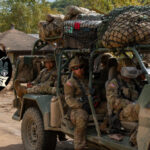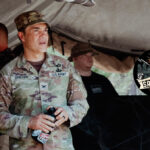
When you talk about the millennial generation a lot of them want some kind of fulfillment out of the work that they’re doing and not feel like they’re just gonna be a cog in the machine.
In September of 2019 we introduced you to the Eisenhower Series College Program. Members of the Eisenhower Program began the year on the road visiting colleges and universities, interacting with audiences often unfamiliar with members of the U.S. Military. Unfortunately the DOD’s Travel Policy, as a result of the ongoing COVID-19 Pandemic, has curtailed the Spring schedule for the program. It is our hope at WAR ROOM to bring you a glimpse of what some of those presentations might have looked like via A BETTER PEACE: The WAR ROOM Podcast.
The first three episodes discussed diversity and inclusivity in the military and social media’s impact on national security and technology’s role on the battlefield.
In this fourth and final episode of the series A BETTER PEACE editor Ron Granieri is joined by three members of the U.S. Army War College AY20 resident course Aaron Sadusky, Eric Swenson and Melissa Wardlaw. The four of them discuss the relationship between higher education in the United States and the military. Their conversation ranges from compulsory national service, to the impact of current education standards on the military recruiting pool and the all volunteer force, to a free 13th and 14th grade.
Podcast: Download
Subscribe: Apple Podcasts | Spotify | Amazon Music | Android | Pandora | iHeartRadio | Blubrry | Podchaser | Podcast Index | TuneIn | Deezer | Youtube Music | RSS | Subscribe to A Better Peace: The War Room Podcast
Aaron Sadusky is a Lieutenant Colonel and a Field Artillery Officer in the U.S. Army. Eric Swenson is a Colonel and an Engineer in the U.S. Army. Melissa Wardlaw is a Lieutenant Colonel and a Medical Operations officer in the U.S. Army. All three of them are graduates of the AY20 resident class at the U.S. Army War College. Ron Granieri is an Associate Professor of History at the U.S. Army War College and the Editor of A BETTER PEACE. The views expressed in this presentation are those of the speakers and do not necessarily reflect those of the U.S. Army War College, U.S. Army, or Department of Defense.
Photo Description: AmeriCorps is potentially one of the national service options spoken of in this episode. It is a network of national service programs, made up of three primary programs that each take a different approach to improving lives and fostering civic engagement. Members commit their time to address critical community needs like increasing academic achievement, mentoring youth, fighting poverty, sustaining national parks, preparing for disasters, and more.
Photo Credit: Photographer unknown
Also of possible interest
Other releases in the “Eisenhower Series”:
- THE REAL FOREVER WAR: THE WAR ON DRUGS
(EISENHOWER SERIES) - GREAT POWER COMPETITION: ALLIANCES IN INDOPACOM
(EISENHOWER SERIES) - PRESERVING DOMESTIC SECURITY
(EISENHOWER SERIES) - OBSERVATIONS FROM NATO’S NORTHERN FRONT REVISITED
(EISENHOWER SERIES) - THE EISENHOWER SERIES COLLEGE PROGRAM: 50 YEARS OF OUTREACH
(BACK TO SCHOOL) - TO WHAT END? INTERESTS AND VALUES IN AFGHANISTAN
(EISENHOWER SERIES) - RECONSIDERING GREAT POWER COMPETITION
(EISENHOWER SERIES) - STRATEGY FROM THE INSIDE OUT
(EISENHOWER SERIES) - SERVICE TO THE NATION: CLOSING THE CIVIL-MILITARY DIVIDE
(EISENHOWER SERIES) - NEW WEAPONS FOR NEW DOMAINS?
(EISENHOWER SERIES)





Good program!
The Draft was something that everyone just accepted as a fact. Though much is made of the protests of the time, the college profs stoked the fires of discontent (much like their personal opinions they teach as fact today), they were not the norm. When men entered the Army during Vietnam, test scores were used to determine what MOSs they were qualified to have. Other factors, such as college classes would be factored into this determination, as well as what jobs you may have had and when you planned to enter the service (if you were enlisting, instead of being drafted). Only 38% of the total draftees even went to Vietnam. During those times, the Army also found most of its troops in the south and southwest.
Though because it is not “correct” today to verbalize it, most Vietnams veterans, including myself, are glad that women were not present in our units because we are sure that their would have been more soldiers listed on The Wall. Like it or not and unapologetically, boys were raised to be men and protect women. The first instinct then would have been to protect them and more would have died.
After Vietnam, there were still problems with soldiers coming in and having to attend remedial math sessions convened in order for soldiers to actually do their jobs they were supposedly already trained for. Today, the situation has become worse than then with the imposition of Common Core. Unfortunately, the states were sold a bill of goods (just like the “New Math” was). Though the emphasis is supposedly on Math and Science, in reality each component is glossed over. Having taught for a while, I once had a principal say that there was nothing wrong with students not memorizing their multiplication tables because anything they needed to do was on-line! History is an afterthought and has become video events than actually studying – which is also so very obvious today. Today, colleges have to test high school student for entry and have had to impose remedial classes before they can actually begin. Further, some have given up on ACT/SAT scores, though they have become easier over time.
As for the 13-14 year proposal, they would likely still become more make-up events for what schools haven’t done, unless the states (who are all individually responsible for education within their own boundaries) overcome union resistance and hastened the rejection of the Common Core disaster in their states, education will continue to get worse.
Army War Room
In my opinion, we should indeed implement a new Selective Service. Too often, DOD makes the mistake of saying what will make the person the most happy in serving. I would not provide the option of non-military service because this will disunite America as it did in the Vietnam War. During the Vietnam War the rich and politically connected could game the system for their children to escape danger. First, it was a college deferment. Next, were you married and had children. One example was former President Bill Clinton.
I would base our proposed Selective Service on the Israeli Army model. It would pick the very brightest from all the colleges and universities and set them to solve important problems. This has fueled Israel’s innovation factory for decades.
If we want to compare and contrast todays young men with those in 1908, we have this quote, “If the law commands it you must serve in the State militia; in such position it is expected of every man to be sufficiently acquainted with the manual of arms that he can assist in the quelling of any riot.”
Today, we face a problem that colleges and universities and high schools indoctrinate students rather than give them a civics education. I think it best to put the remainder of the draftees in the U.S. Army and the U.S. Marine Corp and give them the full infantry training. This accomplishes many goals.
It builds a readily available body of trained infantry in time of war. We lose most of our men in the infantry. It gives the men drafted skin in the game should a war start. It re-socializes those who have become snow flakes unable to stand adversity. It gives familiarity to many ignorant and afraid of firearms. After service, they may push for improvements in our Army and Marine Corps. Too often, economists have distorted public policy with an undue fetish of cost/benefit analysis which too often results in bad policies because we fail to consider other dimensions of a policy issue.
As we saw in the era before an all-volunteer force, more often politicians calculated more clearly and closely about going to war. They realized that when you committed the U.S. Army you committed the American people. The American people might vote you out of office if you screwed up the decision to go to war. Despite many successes, the American people voted out both former President Harry Truman and former President Lyndon Baines Johnson for bad decisions. Both sought to avoid going to the U.S. Congress for a declaration of war.
SERVICE TO THE NATION: CLOSING THE CIVIL-MILITARY DIVIDE (EISENHOWER SERIES): By Aaron Sadusky, Eric Swenson, Melissa Wardlaw and Ron Granieri June 19, 2020
https://warroom.armywarcollege.edu/podcasts/eisenhower-series/eisenhower-4/
The Compendium of Every Day Wants by Luther Minter Pub. 1908
Page 508
“If the law commands it you must serve in the State militia; in such position it is expected of every man to be sufficiently acquainted with the manual of arms that he can assist in the quelling of any riot.”
https://books.google.com/books?id=B63IRdDTqrkC&printsec=frontcover&source=gbs_ge_summary_r&cad=0#v=onepage&q&f=false
Making Citizens: How American Universities Teach Civics by David Randall
https://www.nas.org/reports/making-citizens-how-american-universities-teach-civics
Secrets To Israel’s Innovative Edge by David Yin
https://www.forbes.com/sites/davidyin/2016/06/05/secrets-to-israels-innovative-edge/#51e9c48f4aec
Forbes: Israel’s Tech Success Fueled by Turning Limitations into Advantages
http://www.thetower.org/3477-forbes-israels-tech-success-fueled-by-turning-limitations-into-advantages/
Componential Theory of Creativity by Teresa M. Amabile
https://www.hbs.edu/faculty/Publication%20Files/12-096.pdf
The Dismal Kingdom: Do Economists Have Too Much Power? By Paul Romer March/April 2020
https://www.foreignaffairs.com/reviews/review-essay/2020-02-11/dismal-kingdom
On Strategy: A Critical Analysis of the Vietnam War by Harry G. Summers Jr.
https://www.commentarymagazine.com/articles/eliot-cohen/on-strategy-a-critical-analysis-of-the-vietnam-war-by-harry-g-summers-jr/